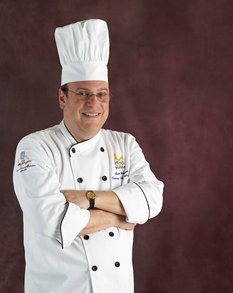Teaching Presentation in 50 Minutes
01 January 2009
 One thing that separates professional cooks from their moms is how they present food. Here are five things students should remember when plating
One thing that separates professional cooks from their moms is how they present food. Here are five things students should remember when plating
By Adam Weiner, JobTrain and the Sequoia Adult School
Students new to cooking go through three stages of trauma. First, they worry about making enough food; second, they agonize on how the food tastes; and finally, they stress about how the food looks. Much of the presentation pain comes from most of the new generation of cooks experiencing “presentation” as bags of fast food in a car seat and “plating” by ordering at the mall’s food court.
I have found the best way to minimize the pain of the third stage is to tell students not to prepare anything until they have in their minds (or better yet, a drawing on paper) how the final plate will look.
Students think this is strange. They feel that if they start cooking, the plating and presentation will fall into place. I explain that if I asked them to build a car, they wouldn’t just pick up some screws, tires, sheet metal and glass and start hammering. They would first have a picture of the finished car. To build a car or a plate of food takes a picture and a plan.
I tell students that one thing that separates professionals from (heaven forbid) their moms is presentation. When deciding how to present food, the student should remember:
- Less is more. Don’t overcrowd the plate. Seeing some of the plate and not having food on the rim is a good thing.
- Reach for the stars. Height is good. Dividing a plate into a protein, starch and vegetable with nothing touching is out of “I Love Lucy.” Stack or layer food, and look for ways to bring height to a plate.
- Be colorful. Think of each plate as an artist’s palette. How can you add color?
- Think texture. Watch “Iron Chef” (particularly the original Japanese version) and count how many times the word “texture” is used. Have contrasts not only in taste and color, but in texture as well.
- Get rid of the parsley and don’t hide the food. Garnishes and sauces should be used to accent the food and chosen as part of the plate design. Throwing parsley on the plate is straight from the drive-in episode of “The Flintstones.” The garnish should always be edible and should be an ingredient that was one of the ingredients in the food. For example, a long piece of chive on top of a baked potato that has chopped chives on it adds height and color. Finally, consider cutting back on the amount of gravy and sauce and putting it under the food.
Next, I bring out two identical fast-food meals. I plate one using the above five rules, with the soda in a frosty glass with the straw hanging on the outside. I leave the other meal in the bag and paper cup. I ask the students which looks more appetizing, reminding them the food is identical. This really gets the point across that presentation matters.
Finally, I remind the students to observe presentation styles on T. V. , in magazines and, more importantly, by looking at plates in restaurants.
Chef Adam Weiner teaches the 12- and 24-week Introduction to Professional Cooking Program for JobTrain and the Sequoia Adult
School on the San Francisco Peninsula. Graduates have gone on to work at Stanford University and Medical Center, Bon Appétit Management Company, Royal Caribbean Cruises, Hyatt and Four Seasons Hotels. Weiner has a California Vocational Teaching Credential and has written more than 40 articles for four different publications. He was nominated by the local ACF chapter as Chef of the Year 2008 and is the Chef Association of the Pacific Coast’s education chairperson. He is also an instructor for the U.S. Navy’s Adopt-A-Ship program.
